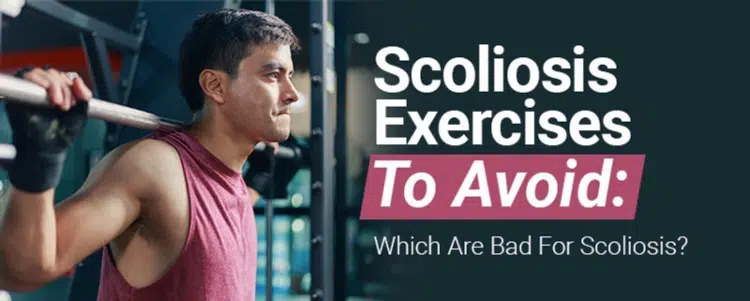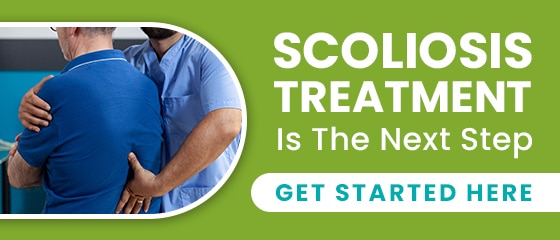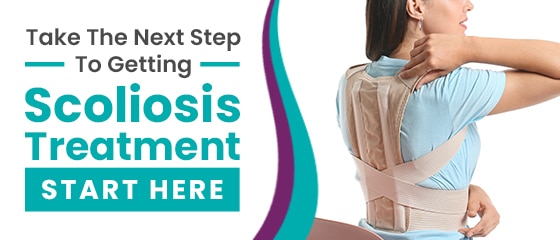We know that leading an active lifestyle carries numerous health and wellness benefits, but what about those living with a progressive spinal condition? Are there certain exercises deemed harmful for someone with an abnormal spinal curvature? Keep reading to find out which exercises should be avoided for people with scoliosis.
There is a big difference between exercises done for general physical fitness or scoliosis-specific exercises (SSEs) prescribed as part of corrective treatment. Scoliosis exercises to avoid would be those that strain the back, overuse one side of the body or involve repeated hyperextension. While heavy weightlifting can pose risks, incorporating body weight exercises can be beneficial for strengthening the spine and maintaining safety during workouts.
No exercise regime should ever be implemented without the official approval of the doctor providing your scoliosis treatment. This is because certain exercises can exacerbate the condition and interfere with treatment efficacy. Before discussing which specific exercises/sports to avoid, let’s talk generally about the place of exercise in scoliosis treatment.
Understanding Scoliosis and Exercise
Living with scoliosis doesn’t mean you have to lead a sedentary lifestyle. In fact, exercise can play a pivotal role in managing the condition. However, it’s crucial to understand which exercises are beneficial and which ones could potentially exacerbate the condition. By working closely with a scoliosis treatment provider, you can develop a personalized exercise plan that supports your treatment goals and overall well-being.
What is Scoliosis?
Scoliosis is a medical condition characterized by an abnormal spinal curvature, which can occur in any region of the spine. This curvature can be caused by various factors, including genetics, muscle imbalances, and degenerative conditions. Scoliosis can lead to postural deviation, where the body’s alignment is off, causing uneven shoulders, hips, and other asymmetries. These imbalances can result in back pain and, in severe cases, breathing difficulties. Understanding the nature of scoliosis is essential for managing its impact on exercise and physical activity.
Signs and Symptoms
The signs and symptoms of scoliosis can vary widely depending on the severity of the condition. Common indicators include uneven shoulders, a prominent shoulder blade, an uneven waistline, or an overall asymmetry in the body’s appearance. While mild cases of scoliosis may not present noticeable symptoms, more severe cases can cause significant discomfort, including back, neck, or lower back pain. If you notice any of these signs, it’s crucial to consult a doctor for a proper diagnosis and to discuss potential treatment options.
How Exercise Affects Scoliosis
Exercise is a vital component of managing scoliosis, but it must be carefully integrated into a comprehensive treatment plan. Scoliosis-specific exercises (SSEs) are designed to address the unique challenges posed by the condition. These exercises can help increase spinal strength and flexibility, making the spine more responsive to treatment. However, certain exercises can worsen scoliosis by exacerbating the abnormal spinal curvature or causing muscle imbalances. Therefore, it’s essential to work with a scoliosis treatment provider to create a personalized exercise plan that meets your specific needs and supports your overall treatment goals.
Exercise and Scoliosis
While the place of exercise in scoliosis treatment was once questioned, we now know that when scoliosis-specific exercises (SSEs) are integrated into a proactive treatment plan, they can help impact the condition on a structural level.
As scoliosis is an abnormal sideways spinal curvature, with rotation, many assume that a life with scoliosis would be sedentary, without regular exercise or sports; this is far from the truth, especially for those following the conservative chiropractic-centered treatment approach I offer at the Scoliosis Reduction Center®.
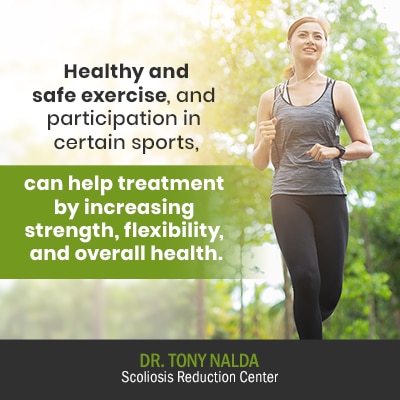
Healthy and safe exercise, and participation in certain sports, can help treatment by increasing strength, flexibility, and overall health.
Staying active and engaging in exercise affects the whole body positively, leading to a healthier attitude and better treatment outcomes.
However, it’s important to understand that there is a big difference between general exercise and sport done for pleasure and general physical fitness, and SSEs that are prescribed as part of a physical therapy program that delivers corrective results.
When used properly and customized to address specific patient and condition characteristics, SSEs can help increase core strength so the muscles surrounding the spine can provide it with better support and stabilization. They can also make improvements to balance, coordination, and body positioning. In addition, SSEs can also help activate certain areas of the brain and work towards improving the brain-body connection.
When people ask which exercises people with scoliosis should avoid, they’re mainly referring to general exercise, which is what we’ll focus on currently, along with addressing some common questions about scoliosis and exercise.
Scoliosis Treatment Options
Scoliosis treatment options vary depending on the severity of the condition. For mild cases, observation and regular monitoring may be sufficient. More severe cases might require interventions such as bracing, physical therapy, or even spinal fusion surgery. Chiropractic care can also play a significant role in scoliosis treatment. Advanced chiropractic adjustments aim to reduce the scoliotic curve by realigning the most-tilted vertebrae at the curve’s apex. Corrective bracing can complement chiropractic care, especially for young patients who have not yet reached skeletal maturity, by pushing the spine into a more corrective position.
Benefits of Physical Therapy for Scoliosis
Physical therapy is a cornerstone of scoliosis treatment, offering numerous benefits that can enhance overall treatment success. A physical therapist can design a personalized exercise program that targets core strength, flexibility, and muscle imbalances. This program may include postural exercises, neuromuscular education, and spinal traction. Physical therapy can also help alleviate pain and improve posture, making it an essential component of a comprehensive scoliosis treatment plan. By working with a physical therapist, individuals with scoliosis can develop a safe and effective exercise routine that promotes optimal spinal support and reduces the risk of treatment complications.
By understanding scoliosis and its impact on exercise, you can take proactive steps to manage the condition effectively. Always consult with your scoliosis treatment provider before starting any new exercise routine to ensure it aligns with your treatment goals and supports your overall health.
Exercises and Sports that People with Scoliosis Should Avoid
As mentioned, when it comes to exercise, and sports that people living with scoliosis should avoid, the list would include activities that involve overusing one side of the body, repetitive shocks, or repeated hyperextension of the spine.
While certain exercises and sports should be avoided, body weight exercises can be a safe alternative that helps strengthen the spine without causing additional strain.
As scoliosis introduces uneven forces and can cause postural deviation related to the body’s overall symmetry, sports or exercises that involve overusing one side of the body play into those asymmetrical effects and can exacerbate symptoms:
- Bowling
- Golf
- Tennis
As scoliosis can lead to postural deviation, it can cause uneven muscle wear. Sports or exercises that don’t work the body’s muscles evenly can exacerbate muscle imbalance and should be avoided by people with scoliosis.
Any exercise or sport that exposes the spine to repeated shocks and/or jarring motions should also be approached with caution as they can increase the compressive forces applied to the spine:
- Weightlifting
- Long-distance running
- Long jump
- Horseback riding
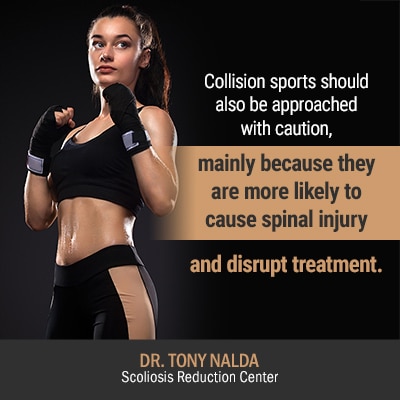
Collision sports should also be approached with caution, mainly because they are more likely to cause spinal injury and disrupt treatment. These types of sports would include:
- Football
- Hockey
- Soccer
- Gymnastics
Exercises and/or sports that involve repeated hyperextension of the spine (arching of the back), can lead to a number of overuse injuries that can impact the spine’s overall health and function. Exercises and sports to avoid due to hyperextension include:
- Certain swimming techniques
- Certain ballet manoeuvres
- Diving
- Gymnastics
- Football
- Volleyball
Although there are a number of sports and exercises that should be approached with caution for people with scoliosis, there are a number of healthy and safe forms of exercise, like walking and planking, that can help increase the chances of treatment success.
Is Walking Good for Scoliosis?
Walking is a great form of exercise for people with scoliosis. While each case is different, as scoliosis progresses, its most noticeable symptoms tend to be pain (more common in adults) and postural changes.
As scoliosis introduces a lot of uneven forces to the body, its visual effects can impact the body’s overall symmetry, with common symptoms including uneven shoulders and hips.
Walking is a safe and healthy form of exercise for people with scoliosis because it doesn’t play into the condition’s asymmetrical effects by overusing one side of the body, nor does it involve repeated jarring motions that can increase compression.
Walking is a safe and healthy activity that increases overall health, flexibility, works the body’s muscles evenly, and pace can easily be adjusted to suit individual fitness levels.
Walking can increase the body’s overall strength and flexibility, not to mention the positive effects that regular walking outdoors can have on mental health.
There are also a number of exercises that are good for people with scoliosis because they increase core strength, which leads to optimal spinal support and stabilization.
Is Planking Bad for Scoliosis?
Planking has gained in popularity over the years as a simple form of exercise because it engages multiple muscle groups evenly and simultaneously. It’s a safe, easy, and simple way to improve core and overall strength.
When a plank is properly performed, its effects are felt in the lower abdominal muscles and the lower back, which are also the muscles heavily involved in spinal support and stabilization.
For those asking, how do I strengthen my core with scoliosis, planking is a potential answer. Increasing core strength is part of effective scoliosis treatment because it takes pressure off the spine; however, some traditional core-strengthening exercises like sit ups, pull ups, and push ups should be avoided by people with scoliosis because they involve unnaturally arching and straining the back.
A spine that’s better supported and stabilized by its surrounding muscles is a spine that has help maintaining its natural and healthy curvatures and alignment.
Just as a person can develop different types of scoliosis, there are different scoliosis treatment approaches for patients to choose between. Fortunately, for those looking for the type of corrective treatment offered to patients here at the Center, my treatment doesn’t commonly include many long-term activity restrictions.
Is Squatting Good for Scoliosis?
People with scoliosis should approach squatting exercises with caution, as the safety and suitability depend on the severity of their condition and individual circumstances. Mild cases may benefit from squats if cleared by a treatment provider, as they can strengthen the core and support spinal health. However, in more severe cases or if squats cause pain, they should be avoided due to the added pressure on the lower back. Proper form is crucial—keeping the chest up, core engaged, and weight balanced—but any discomfort should prompt discontinuation.
Additionally, certain exercises should generally be avoided, including those that overuse one side of the body, hyperextend the spine, involve jarring impacts, or place extra weight on the back. Activities like gymnastics, deadlifting, and high-impact sports may worsen spinal imbalances. Scoliosis-specific physical therapy and approved exercises can help strengthen the core, improve posture, and support treatment, but all exercise plans should be tailored by a specialist to avoid exacerbating the condition.
Corrective Treatment and Activity Restrictions
Part of the reason people so often assume living with scoliosis means a life of limitations is because of activity restrictions, particularly during treatment. While treatment is an intense time of commitment and hard work, I believe that the more active patients can stay, the better it is for their overall health, wellness, and treatment efficacy.
While it’s true that certain collision sports that carry a high risk of spinal injury should be approached with caution, particularly during treatment, those restrictions are neither permanent nor widespread.
As discussed, there is a wide range of sports and exercises that are not only safe for people with scoliosis, but can actually help create conditions within the body that are more conducive to healing and responsive to treatment.
The great news about a conservative chiropractic-centered treatment approach is that when a patient fully engages and complies with the treatment plan applied, they are actually conditioning the body in such a way that many of the restrictions placed on patients following a more traditional treatment approach can be lifted.
As I combine multiple treatment disciplines for an integrative approach that allows me to fully customize each and every treatment plan, patients can often remain active and physically fit throughout treatment and beyond.
The way in which treatment is applied, here at the Scoliosis Reduction Center®, prioritizes the spine’s overall health and function, and this means that one of the primary treatment goals is to make improvements to the spine that make it function better in terms of strength, stability, and flexibility.
By combining scoliosis-specific chiropractic care, in-office therapy, custom-prescribed home exercises, and corrective bracing, my corrective results speak for themselves as patients can go on to live their best lives, despite having scoliosis.
Conclusion
The bottom line is the body, and particularly the spine, was designed for movement. Leading a sedentary life can come with a number of negative consequences, both mentally and physically.
For everyone, staying active is important, but for people with scoliosis, it can be even more important. Incorporating body weight exercises into your routine can help strengthen the spine and support overall health without the risks associated with heavy weightlifting.
Particularly for adult scoliosis patients who tend to experience condition-related pain to varying degrees, scoliosis-specific exercises and stretches can be a positive way of managing pain; keeping the spine and its surrounding muscles as loose and flexible as possible can help alleviate spinal rigidity and pain related to muscle imbalance.
Increasing core strength means the spine has more support from its surrounding muscles, and regular movement helps prevent spinal deterioration by protecting the health of its intervertebral discs; movement is how they regenerate and hydrate.
While no new exercise or sport should be attempted without clearance from the scoliosis-treatment provider, and certain sports and exercises should be approached with caution and may require modifications, scoliosis-specific exercises (SSEs) are an important part of treatment.
It’s also important to understand that because scoliosis is such a highly variable condition, it can range from mild to moderate and severe to very severe. Each case will produce its own unique set of symptoms and related treatment needs based on a number of additional important patient/condition characteristics such as patient age, condition type (cause, if known), and curvature location/pattern.
While certain sports and exercises might not be appropriate for one patient and their condition, they might be fine for another. Every patient needs to have their condition assessed comprehensively so a fully-customized treatment plan can be crafted, and this will involve the prescription of certain scoliosis-specific exercises, and the limitation/modification of others, if needed.
So while each case is different, generally, scoliosis exercises to avoid include those that involve overusing one side of the body as this can exacerbate the asymmetrical effects of the condition and related muscle imbalance.
Activities that involve backbends that repeatedly arch the back unnaturally (hyperextension) should also be approached with caution as this can cause the vertebrae (bones of the spine) to rotate further into the scoliotic curve and lead to further progression. Types of activities and exercises with backbends that could be problematic for scoliosis patients include gymnastics, high jump, diving, and certain swim techniques and ballet maneuvers.
For the best advice on which scoliosis exercises to avoid and include, talk to the doctor providing your treatment; the answer is case-specific and will change based on a number of important patient/condition characteristics.
Here at the Scoliosis Reduction Center®, scoliosis-specific exercises (SSEs) are an integral part of treatment that helps work towards a curvature reduction, strengthening the core muscles, the spine, and improving balance, coordination, and the brain-body connection.
